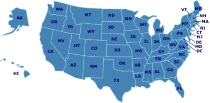Manipulatives
The use of manipulatives are a creative and fun way to introduce and reinforce learning, especially in the area of mathematics.
Resources
Idea Book For Cuisenaire Rods At The Intermediate Level
Grades 2-5. Idea Book designed for use with Cuisenaire Rods.
Flip Over Math Manipulatives
Grades 1-5. Tub of over 500 manipulatives includes Pattern Blocks, Connecting People, Cuisenaire Rods, Coins, and Bean Counters and can be used with the Flip Over Math Books. This 49 page book (others sold separately) is written to NCTM Standards and provide hands on activities from basic math skills to advanced problem solving.
Pattern Blocks and Boards
This set of 10 simply designed colorful wooden blocks and pattern boards includes 100 blocks in six different shapes and colors. They help develop shape recognition and spatial relationship skills. The contents store neatly in a durable wooden case. This games was awarded the Scholastic Parent & Child's 2004 "Top 22 Toys that Make Kids Think" award.
Bead Sequencing Set
Stack the durable, brightly colored wooden beads on 5 hardwood dowels in sequence to match the design on one of the pattern cards. Builds complex reasoning skills as well as sorting and coordination. Includes over 45 brilliantly colored beads, 5 dowels, and 10 patterns that increase in difficulty.
Idea Book For Cuisenaire Rods At The Primary Level
Grades K-4. Each 120 page book contains worksheets and has selected activities that cover the major math standards. Each page outlines the grade level, materials needed, settings, learning experiences, and are based on NCTM Standards.
Cuisenaire Rods Multi-Pack
Grades Pre K & up. An economical way to bring rods into the classroom. Pack contains six sets of 74 rods, six trays with, and Teacher's Guide. For use with 12-18 students.
Using Manipulatives in Your Homeschool
Math-U-See Users Group
This email group is for lovers and users of the Math-U-See program.
How to Make the Most of Math Manipulatives
Marilyn Burns discusses creative and effective ways to use manipulatives to teach math. Much of her information is oriented towards classroom instruction, but there is great information for homeschoolers too. She discusses the seven "musts" for using manipulatives, how to introduce a Geoboard, pattern block activities, and more.
Virtual Manipulatives for Interactive Mathematics
This website features online games and interactive activities designed to help children learn and understand mathematical concepts. You can choose any grade level from pre-K to 12, and subjects including numbers and operations, algebra, geometry, measurements, data analysis, and probability. You'll find virtual peg boards, geoboards, fractals, charts, games, and much more.
5 DIY Manipulatives for Preschool and Kindergarten
These manipulatives are easy to make at home. They provide early learning supplies for anyone on a budget.
Featured Resources
As an Amazon Associate, we earn from qualifying purchases. We get commissions for purchases made through links on this site.
Montessori Play And Learn : A Parent's Guide to Purposeful Play from Two to Six
We all want the best possible starts in life for our children, and one of the best possible starts in life, educationally, is the "method" pioneered by Maria Montessori and taught successfully today throughout the world.Now, Lesley Britton, the leading Montessori practitioner in England for more than twenty years, will show parents how to bring Montessori home. If you would like to facilitate the development of your child's unique personality, make it possible for him to develop to his full inte...
Waldorf Education: A Family Guide
Waldorf Education finds itself catapulted from its humble beginnings 80 years ago into the midst of the central educational and social issues of this decade.What draws parents and educators toward Waldorf Education today? "Waldorf Education - A Family Guide" offers a "first look" for parents and educators into the history, philosophy, curriculum, and traditions of this unique education. This comprehensive book is a collection of articles describing the world of Waldorf Education - the fastest gr...
Elementary Geography
Elementary Geography is a reprint of the original work by Charlotte Mason. It includes her ideas about teaching children about their world, with poetry selections throughout the book. Explores ideas of place from space to our earth, seasons, map making, and topography. Written in a pleasing conversational style, it is useful for understanding teaching methods, memorization, and copy work.
Pecci Reading Method: At Last! A Reading Method for Every Child
At Last! A Reading Method for Every Child offers a balanced approach with intensive phonics and literature-based reading instruction. This is a simple method of teaching reading, with lots of supplemental materials. Get product information here.
Serving Homeschooled Teens and Their Parents (Libraries Unlimited Professional Guides for Young Adult Librarians Series)
This guide for librarians addresses the needs of homeschooled teens and how a library can meet those needs. Includes ideas like developing a homeschool resource and book collection to creating special homeschool programs. While this book was written for library staff, it is also an insightful guide into how homeschoolers and libraries can work together.










